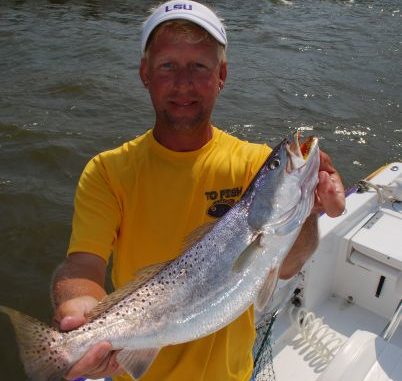
Capt. Greg Schlumbrecht details how to fish the Trestles
Lake Pontchartrain is hallowed ground when it comes to trout fishing, but it’s notoriously finicky. So it’s vitally important to understand exactly how to trigger strikes from the lunker trout that roam those waters.
And there’s no better resource than Trout Masters Too: How the pros do it, which includes tips for fishing Lake Pontrchartrain by veteran guide Capt. Greg Schlumbrecht of To Fish Charters.
Here are his thoughts:
The artificial lures that he uses are Deadly Dudley Bay Choveys — start to finish. Color-wise, the dingier the water is, the darker the lure color he uses; the clearer it is, the lighter the color. Dark-colored favorites are slammin’ sammy and midnight blue moon. Lighter colors that he uses are blue moon and opening night, with the latter being his favorite all-around color.
The jighead he uses with these tails is an unpainted 3/8-ounce version with a Mustad hook. “Paint doesn’t matter,” he says. “Bouncing the lures off bridges, the paint is gone in 30 casts.”
Schlumbrecht shows his roots as a bass fisherman when he talks about fishing technique and plastics. “Technique is absolutely, positively the key to fishing successfully in this lake. The key to technique is keeping the bait in contact with the bottom and working it slowly.
“You have to have very sensitive equipment so that you can feel everything. The fish tell you how to work it. Sometimes I do a single bounce (off the bottom), sometimes a double bounce, sometimes a pop.
“Sometimes the fish are right next to the pole (a term used by Lake Pontchartrain trout fishermen for a bridge piling). Other times they are 20 to 30 feet off the pole.”
Fishing bridges with plastic-tipped jigs is so important to Lake Pontchartrain fishermen that Schlumbrecht provides a complete discourse on the subject, bridge by bridge.
The Trestles has produced some really nice trout in recent years. On a falling tide, Schlumbrecht’s first choice of where to fish is the east or downcurrent side. The direction he fishes will depend on wind direction, as a strong wind can make using a trolling motor difficult.
Because water current hits the poles diagonally, he prefers to start fishing from north to south, but has no problem fishing in both directions. The entire length of the bridge is fishable. If he doesn’t get any takers, he will move to the other side of the bridge, a tactic called “fishing backward.”
As with the Highway 11 bridge and the I-10 twin spans, he typically starts at the Trestles by trying to cast the bait as close to a pole as possible, fishing both sides and the front of the pole. Throwing under the Trestles is a no-no. The concrete span is built over the footprint of an old wooden bridge, so the bottom is rife with hangs.
Similar to fishing the other bridges, including the Causeway, the goal of each cast to a pole is to get the bait to fall straight down to the bottom right next to the pole. Two tactics can be used to accomplish this.
First, the reel can be allowed to free-spool until slack appears in the line, and only then is the reel engaged.
Alternatively, the cast may be ended with the rod tip held straight up in a 12 o’clock position, and then — with the reel engaged — the rod tip is gradually lowered until the rod is level with the water. The advantage in the second approach is the ability to feel a hit while the lure is dropping to the bottom.
If casts next to a pole on all three sides produce no hits, casts should be made that probe waters away from the pole. Speckled trout may be as far as 30 feet off the poles.
Learn more about how the best guides and anglers across the Louisiana coast catch trout day in, day out by purchasing the Trout Masters Tool Kit, which includes a special package price for Trout Masters: How Louisiana’s Best Anglers Catch the Lunkers and Trout Masters Too: How the pros do it .


